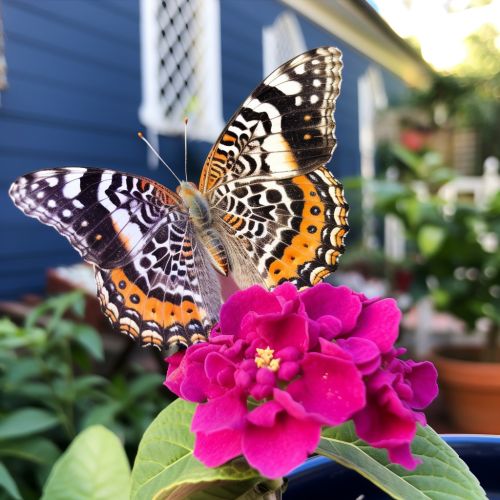Painted Lady butterfly
Taxonomy and Nomenclature
The Painted Lady butterfly, scientifically known as Vanessa cardui, is a well-known colourful butterfly, belonging to the family Nymphalidae. The genus Vanessa comprises a number of striking, medium-sized butterfly species, while the species name cardui is derived from the Latin word for thistle, indicating one of the primary host plants for this butterfly's larvae.
Description
The Painted Lady butterfly is medium-sized, with a wingspan ranging from 5 to 9 cm. The upper side of the wings is covered with a complex pattern of black, orange, and white. The hindwings possess five small submarginal eyespots. The undersides of the wings are pale, with a complex pattern of eyespots and additional markings.


Distribution and Habitat
Vanessa cardui has a cosmopolitan distribution, being found in Europe, Asia, Africa, North America, and Australia. It is one of the most widespread of all butterfly species. The Painted Lady butterfly inhabits a variety of open and semi-open habitats, including meadows, gardens, and disturbed areas.
Life Cycle
The life cycle of the Painted Lady butterfly consists of four stages: egg, larva (caterpillar), pupa (chrysalis), and adult butterfly.
Eggs
The female Painted Lady butterfly lays her eggs singly on the leaves of host plants. The eggs are light green and barrel-shaped, with longitudinal ridges.
Larvae
The caterpillars of Vanessa cardui are multi-coloured, with shades of black, brown, and yellow. They are covered with spines, giving them a somewhat bristly appearance. The caterpillars feed on a wide range of host plants, particularly thistles and other members of the Asteraceae family.
Pupae
The pupal stage, or chrysalis, is a resting stage during which the caterpillar undergoes metamorphosis into an adult butterfly. The chrysalis of the Painted Lady butterfly is greyish-brown, with gold spots, and is attached to a leaf or stem by a silk girdle.
Adults
Adult Painted Lady butterflies feed on nectar from a variety of flowering plants. They are strong fliers and are known for their long-distance migrations.
Behaviour and Ecology
Painted Lady butterflies are diurnal, being most active during the day. They are solitary insects, but may be seen in large numbers during migration periods. The butterflies are known for their territorial behaviour, with males often defending areas with abundant nectar sources.
Conservation Status
The Painted Lady butterfly is not currently listed as threatened or endangered. However, like many insect species, it may be impacted by habitat loss and the use of pesticides.
